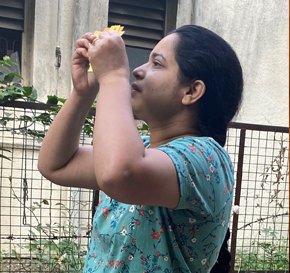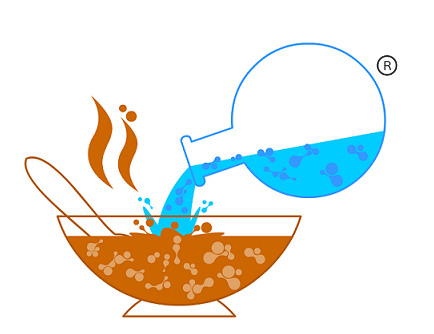
The purpose of this blog is to share the experiences of women in science in India who have returned to the workforce after career breaks (‘comeback queens’), and translate their personal experiences into possible policy and administrative implementations. In doing so, we believe that this series of blogs will highlight these inspirational stories, and provide role models to several women who are currently in career breaks or returning to the workforce. In addition, we intend for it to send out a strong message to young women (students, researchers) in Indian science, that the balance between personal and professional goals can be achieved, with relatable, real-life examples.
DEC 30, 2021 | BY POONAM THAKUR, ANNAPOORNA P. K.
Rohini Karandikar, Science Writer, JoVE
 Tell us about your journey in STEM. Why did you leave STEM?
Tell us about your journey in STEM. Why did you leave STEM?
As a Ph.D. student at IIT Bombay, I realized that bench work was not my cup of tea. However, I enjoyed being a teaching assistant for Microbiology and Biochemistry laboratories. Students often said, “You should take up teaching.” I also enjoyed reading and talking about popular science topics. I volunteered a couple of times for the department seminar club. I enjoyed giving talks on Biomimicry, Serendipity in Cancer research, to name a few topics. Around the same time, I enrolled in an open online course on Writing in the Sciences offered by Stanford University and started writing my blog. I found my heart in science communication. But, Science communication was not a mainstream career option then.
My career break of sixteen months happened after my thesis submission in Sept 2015, when I joined my husband in Liverpool, UK where he was doing his post-doctoral research. Our son was one year old then, and I decided to take a break purposely.
How was the experience of returning to the workforce? What were the major challenges, and how did you overcome them?
We returned to India in Jan 2016. I applied for the post of a Visiting Fellow at Homi Bhabha Centre for Science Education and was offered the position. This turned out to be an excellent opportunity for me to switch from research in core biology to science education. The transition was quite a challenge. But, I considered this a chance to interact with school students and teachers and develop my teaching skills. My mentors, Prof. Sugra Chunawala and Prof. Aniket Sule, encouraged me to take up science communication along with teaching and resource development. I started writing and publishing popular science articles in English as well as Marathi. I was also selected for the Workshop for Women in Science Journalism, organized by IndiaBiosciences. The workshop helped me take my science writing to another level and changed the way I looked at science communication as a career option.
At HBCSE, my friend Rafikh Shaikh introduced me to the Foldscope, an origami microscope developed by Manu Prakash, Asso. Professor at Stanford University. I have been exploring the microbial world for more than two years now. I have recently joined Open Field Collective for their project on Monitoring Algal Blooms, funded by National Geographic.
What is your current role?
I am currently working as a science writer with JoVE, where I write bite-size scripts and create storyboards for concepts in biology for undergraduate students. Outside of my job, I am also a fact-checker with Health Analytics Asia and a part of the Indian Scientists Response to COVID-19 (ISRC) team. With ISRC, I have been writing short explainers for debunking myths related to COVID, translating resources in Marathi, and answering questions in Marathi and Hindi during live call-in sessions. For the first time, I communicated science in all the languages I write and speak. I write scripts and talk about various topics in science in Marathi for my friend-Vihag Ghalsasi’s youtube channel- Kutuhal
Do you think taking a career break affects working potential? If yes, what did you do additionally to revive your career?
A career break, in my opinion, is a chance to rediscover oneself. I took up new hobbies, spent time with loved ones, and learned something new every day. I was around my little one for most of the time and had a memorable time! I utilized my career break to read about science education and the challenges we face in India. I also enrolled in several open online courses and joined the National Waterways Museum, Liverpool as an outreach volunteer. On weekends, my husband would babysit our son, and I would travel to nearby locations in Liverpool and engage school children in activities related to canals and rivers. I also started crocheting as a hobby, and I continue doing it.
Do you have any advice for women/someone in the process of re-entering the workforce?
It is natural to feel overwhelmed while re-entering the workforce. Women have to shoulder the additional responsibility of ensuring that things at home are managed while they go to work, especially if the woman is caring for a child or an elderly. Thankfully, many workplaces offer support to working women in terms of flexible timings. We all have started working remotely since the start of the pandemic, so one can work from home without being guilty about not going to the office. Social media and networking are wonderful channels for support. It is essential to enjoy the journey of re-entering the workforce, which is a chance for growth. Notably, “being a woman” should not become an obstacle in the career path. Hobbies developed during the career break are good stress-busters.
Aditi Bhattacharya, Cactus Life Sciences
 Both sides now: treading the academia-industry divide
Both sides now: treading the academia-industry divide
These days when I think of career transitions, chat with other women on this, almost on cue the iconic song by Joni Mitchell plays in my head. While so much is written on the paucity of growth in academia and lack of freedom of expression in industry that it really behoves the people who’ve crossed that bridge to open up and speak.
Academic Journey:
My interest in neuroscience started at a very early age. My mother, being a clinical psychologist, specializing in neurodevelopmental disorders, exposed me at a very early age to a concept that is now called as “Neurodiversity”. Being a child of a 1980-90s (there I’ve dated myself), cellular signalling, pathways and genetic engineering advances left a deep impact on me and by the time I joined Sri Venkateswara College at Delhi University for my biochemistry major, I was certain I wanted to find molecular cures to neurodevelopmental disorders.
On joining National Centre for Biological Sciences (NCBS), for my Integrated-MS-PhD, I chose to study serotonin receptor trafficking and antipsychotic drug signaling working to understand molecular gears that underlie mental health and disease. NCBS was a transformative experience sculpting the fundamentals of my scientific world view. However familial exposure to finance and entrepreneurship had sensitized me to industrial implications of biotechnological work. At that time, there was little avenue to balance and pursue both interests in India. Starting my post-doctoral tenure, in 2010, took me to the Centre of Neural Science, New York University, and closer to Autism research and industrial innovation.
Apart from the wealth of knowledge and international exposure I gained, I also connected with an aspect of the disease space that has incredible impact- the patient journey. Interacting with patient advocacy groups, during clinical trials , brought home to me the importance of disseminating clinical research accurately. In 2015, I was provided an opportunity to return to India as an Independent Investigator, at the Institute for Stem Cell Biology & Regenerative Medicine to engage in characterization of a wide range of autism rat models. Though, this brought me back to familiar playgrounds to do cutting edge basic research, the need to understand clinical trials and communication research to patients better persisted. Hence to work towards my goal of finding tangible solutions for autism, coupled with narrowing avenues of carrying my specific research forward conveyed to me that I had to “trans”-skill.
The jump:
While the world was coming to grips with the phenomenon of SARS-Cov2, I got an opportunity to lead operations for scientific publications at Cactus Life Sciences. The woman-centric culture of Cactus and its format of remote working, with teams spread across the world, was very attractive. In the past 15 months or so, I have had the opportunity to work with a large number of big pharmaceutical companies, spanning countries as varied as Japan, Switzerland and USA and in therapeutic areas ranging from dermatology, immunology, cancer and gastroenterology which is far removed from my neuroscience comfort zone. Apart from content, I have been exposed to business and corporate culture, management and strategic planning.
To say that this period has been educational would be an understatement. The fast-paced, generalist and dynamic environment of industry is a far cry from the ultra-focussed and leisurely ecosystem of academia. While I learn multiple things on the job every day, it is undoubtedly demanding and especially so while surviving lock-downs, balancing household duties, caring for aging parents and juggling my son’s online classes! I have been blessed with an immensely supportive safety net of my husband, parents and in-laws and they again rallied around me to help me tide over this crazy new job+pandemic combination. I also am fortunate to have a wonderful team made up of almost entirely women and a super awesome boss who is also my first woman supervisor. The bond that this creates in a fast-paced and often-stressful environment is something that I thoroughly enjoy. I have realized that my career progression from this point will always remain a “work-in-progress” as I find more places to apply my gathered experience to find solutions to a wide-range of biotech problems.
What is the parachute?
As with returning from a career break, women deciding to take the plunge into the extra-academic waters often are faced with four major challenges:
1. Knowing what are the skills that one has, that are of value to companies,
2. Overcoming the fear of stepping out of the comfort zone,
3. Developing a network that supports you with information and counsel,
4. Knowing the array of jobs that are in the market
Each of these takes time and effort to develop and one should be willing to devote time to this well in advance to starting the hunt for job. This not only helps tailor the CV better for the jobs at hand but also in preparing for a potential interview. Increasingly one sees more biotech related openings being posted on national and international job portals. At times, the need for a job transition becomes urgent and time-bound. In these cases, the utility of a varied network becomes apparent. It is also recommended to explain the reasons for transitioning in the clearest terms at recruiting interviews.
Developing a sisterhood
Transitions of any form, be it resuming after a career break, or from academia to industry or from one type of role to another, require planning, the acceptance that failures outnumber success and that path is never straight. With the growing realization that remote work is not only possible but also productive, career paths are not ladders but more free-form, and most importantly balancing work-life pressures is paramount for all, women are presented with a wide array of opportunities. All it needs is a pinch of courage, lots of hard work, a dash of re-invention and a small helping hand.
For this SciSoup Career break blog 2021, Participants were interviewed by Dr. Poonam Thakur, Assistant Professor and DBT / Wellcome Trust India Alliance Fellow, IISER-Thiruvananthapuram, Kerala, and Annapoorna P K, Graduate student, CSIR-CCMB, Hyderabad, India.

Send your opinions, questions, and suggestions for future column topics and stories - to scisoup@gmail.com and engage with us on